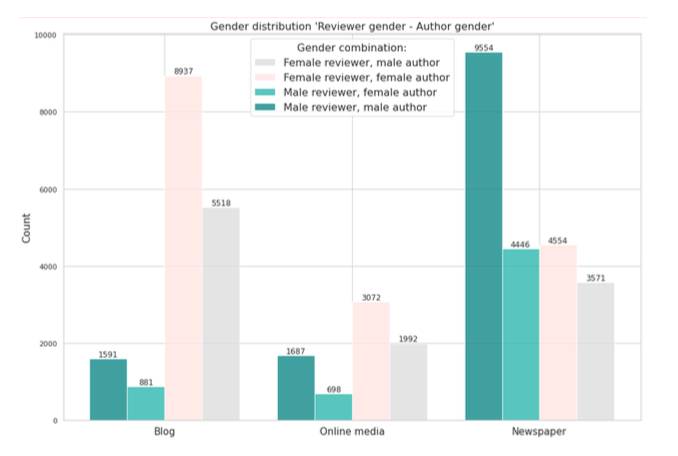Recent research by Fabula-NET shows that Danish literary criticism is characterized by a gender imbalance. Based on a data set containing 57.369 book reviews of fiction from 2010 to 2021 obtained from bog.nu (a site containing all Danish book review gradings from the preceding decade), the research group has examined the division of review gradings in terms of gender across different media types. The study is part of Fabula-NET’s broader interdisciplinary research project investigating notions of literary quality and reader preferences.
The data set shows a very distorted gender distribution across media types (including newspapers, blogs, and online media). Whereas reviews in newspapers are clearly dominated by male reviewers reviewing male authors, reviews of female authors by female reviewers dominate the blogosphere. (Note: The study is based on a binary understanding of gender which excludes other gender identities. Though in some respects problematic, working with a binary understanding of gender has been requisite in order to examine gender structures within Danish literary criticism.)

Newspaper reviews
A certain ‘grading behaviour’ characterizes the 24.000 newspaper reviews from the data set. The results show that the gradings in Danish newspaper reviews are, statistically, affected by the gender of both the reviewer and the reviewed author: male reviewers tend to grade male authors higher, whereas female reviewers tend to assign lower grades to female authors. More specifically, the highest grades are assigned by male reviewers to male authors with a 0.2 average grade increase compared to female authors reviewed by female reviewers – a difference demonstrating statistical significance.

Same gender reviews thus represent the extreme values, representing both top and bottom on the grading scale. By contrast, this deviation does not characterise review gradings across gender, that is when male reviewers grade female authors and vice versa – here, the gradings are more average though they differ from same gender reviews with 0.1 grade points.
The gender imbalance within newspaper reviews does not, however, characterize the grading behaviour alone: two thirds of Danish newspaper reviewers are male and male authors are reviewed more often than female authors in newspapers. More specifically, 3 out of 5 book reviews in Danish newspapers are of books written by men. Though the study does not rely on specific publishing numbers of men and women in general, this division seems conspicuous when compared to the approximately 50/50 division between publications of female and male authors by large Danish publishing companies such as Gyldendal. Despite a minor increase in the fraction of female authors being reviewed in Danish newspapers between 2010 and 2021, the period is still dominated by a relatively stable fraction of male reviewers.
When leaving the newspaper reviews out of account, the data set shows, however, that the highest review gradings altogether are assigned to female authors on internet blogs (typically written by women). The gender deviation characterising the literary criticism in newspapers are thus not representative of the Danish review culture at large but testifies to a specific gender imbalance within newspaper criticism.
Interpretations and reservations
As the study is based on statistical analysis, the data set cannot definitely conclude whether the gender imbalances result from bias - though the results do give rise to questions of prejudice and bias, answering such questions needs deeper investigation. Several possible explanations do, however, seem plausible: with male reviewers and male authors dominating newspaper reviews, the reversed pattern characterizing female reviews of female authors within newspaper criticism could reflect an adjustment to the dominating structure. The assumed gender bias is, however, possibly confounded with a potential expertise bias, meaning that the deviation could also reflect different gradings of specific types of literature. A genre classification of all the reviewed books in the data set would clarify if women write more genre literature and are therefore assigned lower grades than men.
Some reservations characterize the study as the project is, to a certain extent, reliant on estimated numbers from bog.nu as some newspapers do not use grading systems in book reviews (Information, Weekendavisen). Additionally, bog.nu does not register gender. An API has therefore been applied to give a probability of the gender of a given author based on the provided name. Despite such minor pitfalls, the potential sources of error are not expected to have affected the overall outcome of the study.
With a significant difference in average gradings between male authors reviewed by male reviewers and female authors reviewed by female reviewers in Danish newspapers in the period 2010-2021, the results testify to a systematic imbalance. Though the effect size (0.2 points on the six-point scale for same gender) may seem inconsiderable, the study demonstrates a significant and recurrent, structural imbalance. The study does not, however, claim that individual reviewers or institutions are particularly biased; the results are more likely to reflect a structural gender imbalance on a societal scale.
The preprint of the study can be downloaded here: https://arxiv.org/abs/2206.08697.